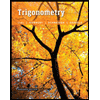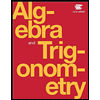Given the value of one trigonometric function of an acute angle 0, find the values of the remaining five trigonometric functions of 0. Give the exact answer as a simplified fraction, if necessary. Rationalize denominators if necessary. tan 0= 2 0/0 2 0/6 X Subm Part 1 of 5 Part 2 of 5 cos 0 = S S
Given the value of one trigonometric function of an acute angle 0, find the values of the remaining five trigonometric functions of 0. Give the exact answer as a simplified fraction, if necessary. Rationalize denominators if necessary. tan 0= 2 0/0 2 0/6 X Subm Part 1 of 5 Part 2 of 5 cos 0 = S S
Trigonometry (11th Edition)
11th Edition
ISBN:9780134217437
Author:Margaret L. Lial, John Hornsby, David I. Schneider, Callie Daniels
Publisher:Margaret L. Lial, John Hornsby, David I. Schneider, Callie Daniels
Chapter1: Trigonometric Functions
Section: Chapter Questions
Problem 1RE:
1. Give the measures of the complement and the supplement of an angle measuring 35°.
Related questions
Question
![**Title: Finding Trigonometric Functions**
**Objective:**
Given the value of one trigonometric function of an acute angle θ, find the values of the remaining five trigonometric functions of θ. Give the exact answer as a simplified fraction, if necessary. Rationalize denominators if necessary.
**Problem Statement:**
Given:
\[ \tan \theta = \frac{2}{5} \]
**Tasks:**
**Part 1 of 5:**
Determine the value of \(\sin \theta\).
**Part 2 of 5:**
Determine the value of \(\cos \theta\).
The problem continues with three more parts to find the remaining trigonometric functions: \(\cot \theta\), \(\sec \theta\), and \(\csc \theta\).
**Solution Guide:**
1. **Identify the given function**:
- Here, \(\tan \theta = \frac{2}{5}\).
- This represents \( \tan \theta = \frac{\text{opposite}}{\text{adjacent}} \). So in a right triangle, the opposite side to the angle θ is 2 units, and the adjacent side is 5 units.
2. **Calculate the hypotenuse** using the Pythagorean theorem:
\[ \text{hypotenuse} = \sqrt{(\text{opposite})^2 + (\text{adjacent})^2} \]
\[ \text{hypotenuse} = \sqrt{2^2 + 5^2} = \sqrt{4 + 25} = \sqrt{29} \]
3. **Find the trigonometric functions**:
- **\(\sin \theta\)**:
\[ \sin \theta = \frac{\text{opposite}}{\text{hypotenuse}} = \frac{2}{\sqrt{29}} \]
Rationalize the denominator:
\[ \sin \theta = \frac{2}{\sqrt{29}} \cdot \frac{\sqrt{29}}{\sqrt{29}} = \frac{2\sqrt{29}}{29} \]
- **\(\cos \theta\)**:
\[ \cos \theta = \frac{\text{adjacent}}{\text{hypotenuse}} = \frac{5}{\sqrt{](/v2/_next/image?url=https%3A%2F%2Fcontent.bartleby.com%2Fqna-images%2Fquestion%2Fd9ae2b74-0627-461f-a855-f05238f3c436%2F06015f9d-b69a-4e92-b0bf-f9d7774361b6%2Flknbtp4_processed.jpeg&w=3840&q=75)
Transcribed Image Text:**Title: Finding Trigonometric Functions**
**Objective:**
Given the value of one trigonometric function of an acute angle θ, find the values of the remaining five trigonometric functions of θ. Give the exact answer as a simplified fraction, if necessary. Rationalize denominators if necessary.
**Problem Statement:**
Given:
\[ \tan \theta = \frac{2}{5} \]
**Tasks:**
**Part 1 of 5:**
Determine the value of \(\sin \theta\).
**Part 2 of 5:**
Determine the value of \(\cos \theta\).
The problem continues with three more parts to find the remaining trigonometric functions: \(\cot \theta\), \(\sec \theta\), and \(\csc \theta\).
**Solution Guide:**
1. **Identify the given function**:
- Here, \(\tan \theta = \frac{2}{5}\).
- This represents \( \tan \theta = \frac{\text{opposite}}{\text{adjacent}} \). So in a right triangle, the opposite side to the angle θ is 2 units, and the adjacent side is 5 units.
2. **Calculate the hypotenuse** using the Pythagorean theorem:
\[ \text{hypotenuse} = \sqrt{(\text{opposite})^2 + (\text{adjacent})^2} \]
\[ \text{hypotenuse} = \sqrt{2^2 + 5^2} = \sqrt{4 + 25} = \sqrt{29} \]
3. **Find the trigonometric functions**:
- **\(\sin \theta\)**:
\[ \sin \theta = \frac{\text{opposite}}{\text{hypotenuse}} = \frac{2}{\sqrt{29}} \]
Rationalize the denominator:
\[ \sin \theta = \frac{2}{\sqrt{29}} \cdot \frac{\sqrt{29}}{\sqrt{29}} = \frac{2\sqrt{29}}{29} \]
- **\(\cos \theta\)**:
\[ \cos \theta = \frac{\text{adjacent}}{\text{hypotenuse}} = \frac{5}{\sqrt{
Expert Solution
This question has been solved!
Explore an expertly crafted, step-by-step solution for a thorough understanding of key concepts.
This is a popular solution!
Trending now
This is a popular solution!
Step by step
Solved in 2 steps with 2 images

Recommended textbooks for you

Trigonometry (11th Edition)
Trigonometry
ISBN:
9780134217437
Author:
Margaret L. Lial, John Hornsby, David I. Schneider, Callie Daniels
Publisher:
PEARSON

Trigonometry (MindTap Course List)
Trigonometry
ISBN:
9781305652224
Author:
Charles P. McKeague, Mark D. Turner
Publisher:
Cengage Learning


Trigonometry (11th Edition)
Trigonometry
ISBN:
9780134217437
Author:
Margaret L. Lial, John Hornsby, David I. Schneider, Callie Daniels
Publisher:
PEARSON

Trigonometry (MindTap Course List)
Trigonometry
ISBN:
9781305652224
Author:
Charles P. McKeague, Mark D. Turner
Publisher:
Cengage Learning


Trigonometry (MindTap Course List)
Trigonometry
ISBN:
9781337278461
Author:
Ron Larson
Publisher:
Cengage Learning